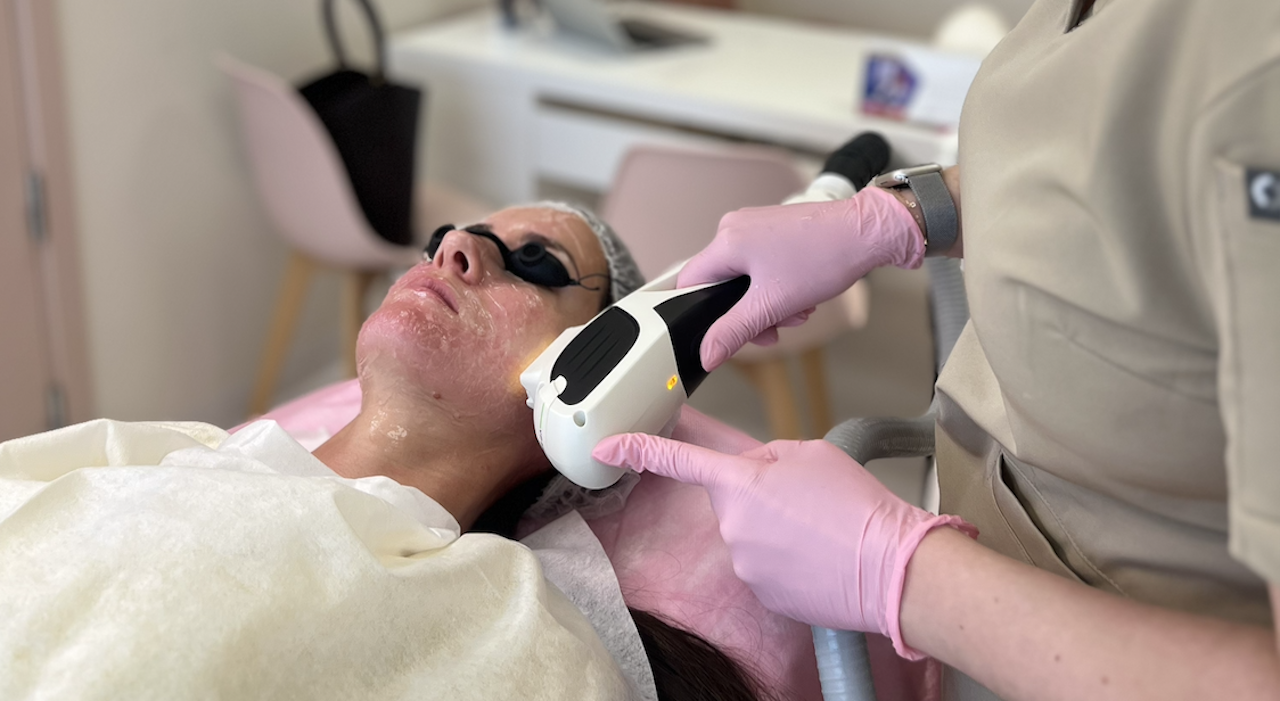IPL (Intense Pulsed Light) is an effective solution for treating facial redness, including couperose and rosacea.
What causes facial redness?
Facial redness is a very common skin concern affecting both men and women. The main causes include environmental factors such as sun, cold, wind, and their constant changes. Genetics and lifestyle choices like smoking, spicy foods, sauna use, and other heat-based procedures also play a role, as they cause constant dilation of blood vessels. Additionally, with age, the skin and blood vessels lose collagen, leading to visible capillaries, especially on the cheeks, chin, and nose (rhinophyma).
Flushing Episodes
Flushing is a frequent and uncomfortable condition for many women, particularly during menopause due to hormonal changes. Other triggers include heat (sun, sauna), alcohol, spicy foods, physical activity, emotional stress, and fatigue.
Couperose
Couperose is a skin condition characterized by visible blood vessels forming thread-like patterns, especially on the face. It appears as fine red or bluish lines caused by dilated blood vessels. Common causes include genetics, sun damage, climate, and skin aging.
Rosacea
Rosacea is a chronic skin condition marked by persistent redness and visible blood vessels, often accompanied by inflammatory, painful breakouts. It typically affects the cheeks, nose, chin, and forehead in a “butterfly pattern.” While rosacea cannot be fully cured, IPL treatment can significantly reduce its symptoms. It’s most common in fair-skinned women aged 30–60. Men are less frequently affected, but their symptoms tend to be more severe. The exact cause of rosacea is unknown, but it’s linked to the Helicobacter pylori bacterium in the stomach, the skin mite Demodex folliculorum, and UV-related damage to blood vessels. Genetics also play a role.
How does IPL treat redness?
IPL uses controlled light at specific wavelengths. These pulses are absorbed by capillaries, causing them to constrict and close, thereby reducing visible redness. It also stimulates collagen production, strengthening blood vessel walls and preventing future breakage. Collagen stimulation improves skin texture and tone and boosts resilience against environmental stressors, helping prevent further inflammation, redness, and swelling. Therefore, IPL also serves as a preventative treatment.
How many IPL sessions are needed for redness?
IPL is very effective for redness treatment. We use high-quality IPL technology (Viora V-20).
IPL works through selective photothermolysis—targeting hemoglobin (the chromophore) in the blood vessels. The light pulses heat the vessels, causing them to collapse and eventually be absorbed by the body, similar to how bruises fade. IPL is also highly effective in treating hematomas (bruises), often clearing them in just 1–2 days (normally they take 10–14 days to heal).
Depending on the severity, 2–4 sessions at monthly intervals are recommended. Effectiveness and duration depend on the patient’s skin characteristics and redness triggers.
When can results be expected?
Depending on the severity, redness may initially increase post-procedure. Mild bruising, flaking, or flare-ups can occur, lasting from a few hours to a few days. Visible improvement typically appears within 2 weeks, with each session yielding increasingly noticeable and long-lasting results due to improved skin quality.
How long do the results last?
The results are long-lasting, but if redness-inducing factors (UV exposure, smoking, heat, alcohol, etc.) persist, maintenance treatments are recommended about once a year. After completing a course, redness is usually significantly reduced or eliminated for 6 months to 2 years. To prolong results, we recommend addressing lifestyle factors (UV protection, avoiding overheating, smoking, alcohol) and using appropriate skincare and sunscreens for sensitive skin.
Who is IPL redness treatment suitable for?
Suitability and risk assessment should be done through a consultation with our clinic’s laser therapy specialist. They will analyze your skin, explain the procedure and expected outcomes, and provide detailed aftercare instructions.
IPL redness treatment indications:
- Redness on the face, neck, and décolletage
- Dilated capillaries
- Flushed cheeks
- Red nose
- Rosacea
- Couperose
- PIH (post-inflammatory hyperpigmentation), including reddish-purple acne scars
- Poikiloderma of Civatte
- Subcutaneous hematomas (bruises)
Pre-treatment guidelines:
- Treat active inflammations beforehand if possible
- Do not undergo the procedure while on antibiotics; wait at least 2 weeks after your last dose
- Inform the clinic of any medications in use
- Discontinue use of retinol or other active ingredients 3 days before the procedure. Resume only after full skin recovery
- Contraindications: chronic inflammation, active herpes, cancer, keloid scars, recent sun exposure, melasma, epilepsy
- Avoid IPL on tanned skin. Wait 2–4 weeks after tanning, and do not use self-tanners 2 weeks before treatment
- Shave the treatment area if dark hair is present
- Not performed during pregnancy or breastfeeding
- Under 18 years old require parental consent
Post-treatment guidelines:
- Mild flushing, redness, and swelling are normal; bruising is rare
- Use a cold compress (from the fridge, not the freezer) to ease discomfort
- Apply healing creams (e.g., Bepanthen, Burnshield, Cicabio, Cicaplast Baume) until full recovery (1–2 weeks)
- Thermal spring water sprays (e.g., Avene, La Roche-Posay) can soothe and hydrate
- Antihistamines (Zyrtec, Claritine) may reduce swelling
- Avoid alcohol for 24 hours
- Avoid intense workouts for 1 week
- No saunas or pools for 2 weeks
- Use SPF 50 sunscreen for at least 2 weeks
- Avoid facial treatments (cosmetic, massage, chemical peels, injections) for 2 weeks post-treatmenr
- Makeup can be applied immediately after the procedure
- Pigment in the skin may darken and form scabs that naturally flake off in 7–10 days—do not pick at them
• Cleanse with gentle products (e.g., mild gel or micellar water)
• For lasting results, use sunscreen year-round

